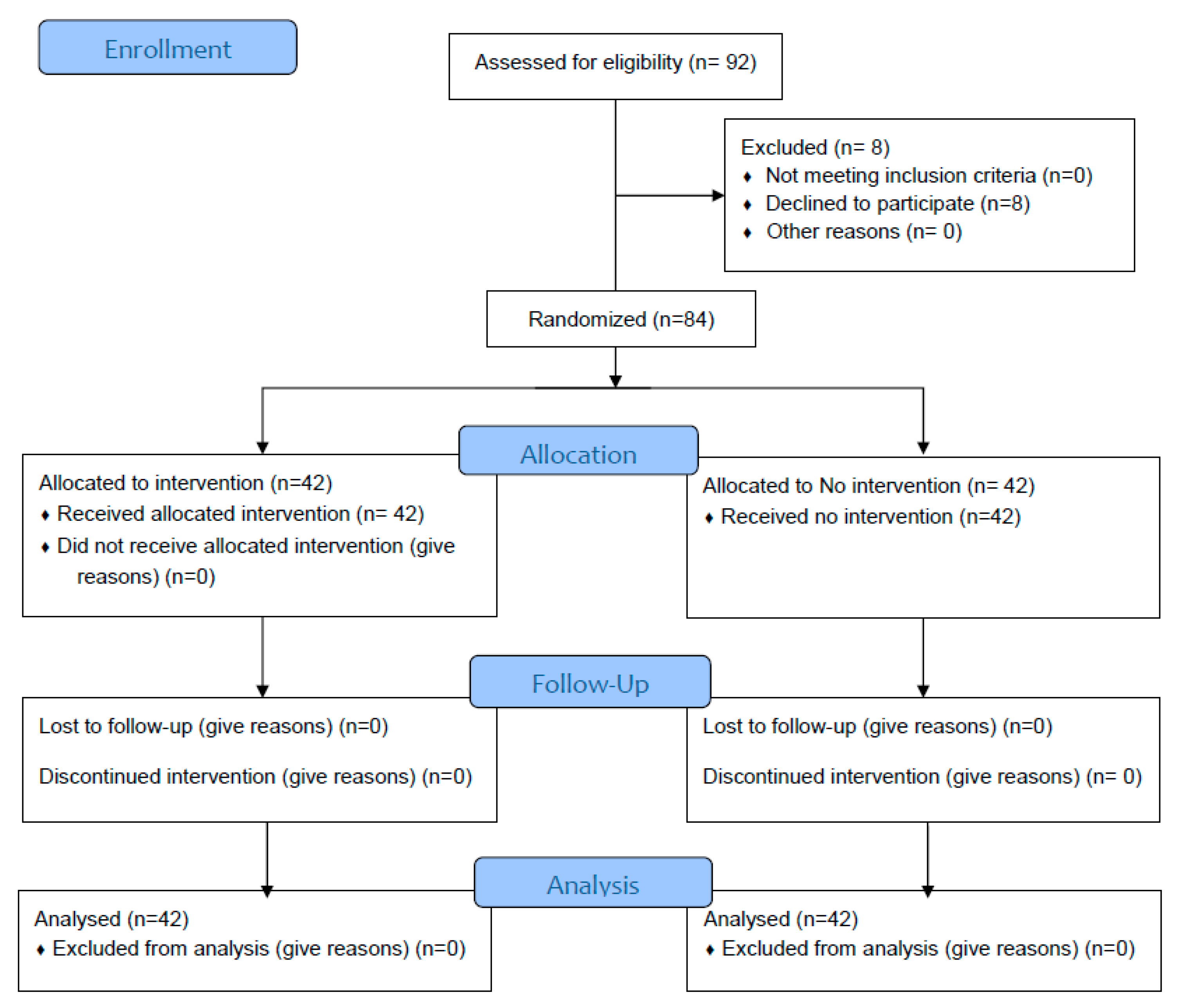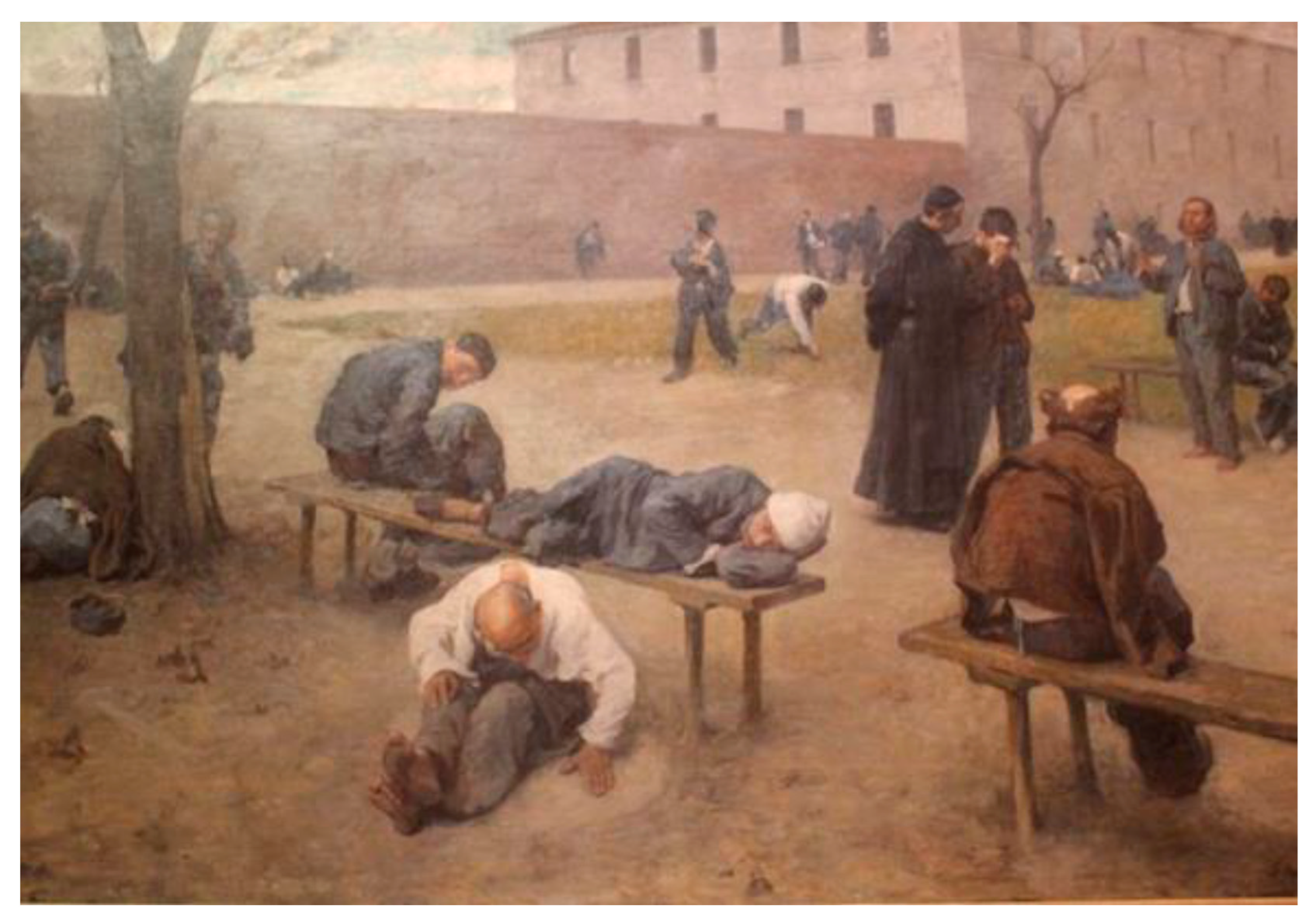Visual Thinking Strategies as a Tool for Reducing Burnout and Improving Skills in Healthcare Workers: Results of a Randomized Controlled Study
Abstract
1. Introduction
- -
- What is going on in this picture?
- -
- What do you see that makes you say that?
- -
- What more can we find?
2. Materials and Methods
Statistical Analysis
- -
- Health-related quality of life, using the SF12 questionnaire, which enabled the calculation of Mental Composite Score (MCS) and Physical Composite Score (PCS).
- -
- Positivity, using Caprara’s Positivity scale.
- -
- Burnout, using the Copenhagen Burnout Inventory, which allowed the following scores to be calculated: Personal burnout, Work burnout, Client burnout.
3. Results
- -
- observational skills: the median differs to be 0 for the control group and 1 for the intervention group, with a maximum of 4;
- -
- language expression: where for the control group the median is 0, for the intervention group it is 1, with a maximum of 4;
- -
- problem solving: similar to the other two, the control group is 0, while the intervention group maximum was 1.
- -
- observational skills: 0 for the control group and 1 for the intervention group with a maximum of 3;
- -
- language expression: 0 for the control group and 1 for the intervention group with a maximum of 3;
- -
- problem solving: maintains the same median of 0, however, has a maximum 3 for the intervention group.
4. Discussion
5. Conclusions
Author Contributions
Funding
Institutional Review Board Statement
Informed Consent Statement
Data Availability Statement
Acknowledgments
Conflicts of Interest
References
- Decreto Ministeriale. Regolamento Concernente L’individuazione della Figura e del Relativo Profilo Professionale Dell’infermiere; 14 September 1994; p. 739. [Google Scholar]
- Toney-Butler, T.J.; Thayer, J.M. Nursing Process. In StatPearls; StatPearls Publishing: Treasure Island, FL, USA, 2022. [Google Scholar]
- Yildirim, B.; Ozkahraman, S. Critical thinking in nursing process and education. Int. J. Hum. Social Sci. 2011, 1, 257–262. [Google Scholar]
- Reilly, J.M.; Ring, J.; Duke, L. Visual thinking strategies: A new role for art in medical education. Fam. Med. 2005, 37, 250–252. [Google Scholar] [PubMed]
- Moorman, M. The Use of Visual Thinking Strategies and Art to Help Nurses Find Their Voices. Creat. Nurs. 2017, 23, 167–171. [Google Scholar] [CrossRef] [PubMed]
- Repar, P.A.; Patton, D. Stress reduction for nurses through Arts-in-Medicine at the University of New Mexico Hospitals. Holist. Nurs. Pract. 2007, 21, 182–186. [Google Scholar] [CrossRef] [PubMed]
- World Health Organization; Division of Mental Health. Life Skills Education for Children and Adolescents in Schools. Pt. 1, Introduction to Life Skills for Psychosocial Competence. Pt. 2, Guidelines to Facilitate the Development and Implementation of Life Skills Programmes, 2nd rev; World Health Organization: Geneva, Switzerland, 1994. [Google Scholar]
- Miranda-Casas, A.; Marco-Taverner, R.; Soriano-Ferrer, M.; Melià de Alba, A.; Simó-Casañ, P. Aplicación de nuevas tecnologías con estudiantescon dificultades de aprendizaje en la solución deproblemas matemáticos: La ‘escuela submarina’ The application of new technologies to solving maths problems for students with learning disabilities: The ‘underwater school’. Rev. Neurol. 2008, 46 (Suppl. S1), S59–S63. [Google Scholar] [PubMed]
- Mitzova-Vladinov, G.; Torrents, H. The Fine Art of Health Care: Visual Thinking Strategies for Interprofessional Skills Development in Graduate Nurse Anesthesia Education. Create. Nurs. 2020, 26, e56–e62. [Google Scholar] [CrossRef] [PubMed]
- Dalia, Y.; Milam, E.C.; Rieder, E.A. Art in Medical Education: A Review. J Grad. Med. Educ. 2020, 12, 686–695. [Google Scholar] [CrossRef] [PubMed]
- Aspden, T.; Egan, J.P.; Bye, L.; Petersen, L. Using Visual Thinking Strategies to Support Pharmacy Student Competency Development to Enable Person-Centered Care. Am. J. Pharm. Educ. 2021, 86, 8607. [Google Scholar] [CrossRef] [PubMed]
- Chisolm, M.S.; Kelly-Hedrick, M.; Wright, S.M. How Visual Arts-Based Education Can Promote Clinical Excellence. Acad. Med. 2020, 96, 1100–1104. [Google Scholar] [CrossRef] [PubMed]
- Agarwal, G.G.; McNulty, M.; Santiago, K.M.; Torrents, H.; Caban-Martinez, A.J. Impact of Visual Thinking Strategies (VTS) on the Analysis of Clinical Images: A Pre-Post Study of VTS in First-Year Medical Students. J. Med. Humanit. 2020, 41, 561–572. [Google Scholar] [CrossRef] [PubMed]
- Ferrara, V.; De Santis, S.; Manicone, F.; Martinino, A.; Consorti, F. The visual art as a learning tool in medical education. Senses Sci. 2020, 7, 1028–1040. [Google Scholar]
- Ferrara, V.; De Santis, S.; Melchiori, F.M. Art for improving skills in medical education: The validation of a scale for measuring the Visual Thinking Strategies method. Clin. Ter. 2020, 171, e252–e259. [Google Scholar] [CrossRef] [PubMed]
- Ferrara, V. L’arte Come Strumento per la Formazione in Area Medica e Sanitaria; Aracne Editore: Rome, Italy, 2020. [Google Scholar]
- Moorman, M. The Meaning of Visual Thinking Strategies for Nursing Students. Humanities 2015, 4, 748–759. [Google Scholar] [CrossRef]
- Shapiro, J.; Rucker, L.; Beck, J. Training the clinical eye and mind: Using the arts to develop medical students’ observational and pattern recognition skills. Med. Educ. 2006, 40, 263–268. [Google Scholar] [CrossRef] [PubMed]
- Poirier, T.I.; Newman, K.; Ronald, K. An Exploratory Study Using Visual Thinking Strategies to Improve Undergraduate Students’ Observational Skills. Am. J. Pharm. Educ. 2020, 84, 7600. [Google Scholar] [CrossRef] [PubMed]




| Control Group Number, Mean (SD) | Intervention Group Number, Mean (SD) | |
|---|---|---|
| Total Number | 42 | 42 |
| Nurses students | 25 | 25 |
| Residents | 17 | 17 |
| Age | 25.1 (2.7) | 25.0 (2.6) |
| Gender | ||
| Females | 30 | 30 |
| Males | 12 | 12 |
| Control Group Median (Min–Max) | Intervention Group Median (Min–Max) | p | |
|---|---|---|---|
| Delta Critical thinking | 0 (−1–1) | 0 (−2–2) | 0.044 |
| Delta Observation skills Clinical Attention | 0 (−1–1) | 1 (−1–4) | 0.006 |
| Delta Linguistic expression | 0 (−1–1) | 1 (−3–4) | 0.009 |
| Delta Word count | −11 (−20–6) | 6 (−43–48) | 0.081 |
| Delta Problem solving | 0 (−1–1) | 1 (−2–4) | 0.008 |
| Delta Identified elements | −1.5 (−5–2) | 1 (−4–7) | 0.007 |
| Total score artistic image | −1.5 (−4–4) | 3 (−6–14) | 0.002 |
| Control Group Median (Min–Max) | Intervention Group Median (Min–Max) | p | |
|---|---|---|---|
| Delta Critical thinking | 0 (−1–1) | 1 (−1–3) | 0.162 |
| Delta Observation skills Clinical Attention | 0 (−1–1) | 1 (−1–4) | 0.007 |
| Delta Linguistic expression | 0 (−1–2) | 1 (−1–3) | 0.028 |
| Delta Word count | 0.5 (−23–8) | 9 (−37–64) | 0.081 |
| Delta Problem solving | 0 (−1–1) | 0 (−1–3) | 0.028 |
| Delta Identified elements | −0.5 (−1–3) | 1 (−2–7) | 0.107 |
| Total score clinical image | 0 (−4–2) | 2 (−2–12) | 0.025 |
| Control Group | Internvention Group | p | |
|---|---|---|---|
| PCS12_pre | 50.91 | 49.79 | 0.672 |
| PCS12_post | 44.64 | 48.46 | 0.108 |
| p | <0.001 | 0.214 | |
| MCS12_pre | 43.01 | 37.78 | 0.220 |
| MCS12_post | 40.72 | 43.05 | 0.899 |
| p | 0.08 | <0.001 | |
| Positivity_pre | 3.31 | 3.31 | 0.882 |
| Positivity_post | 3.31 | 3.25 | 0.783 |
| p | 1.00 | 0.925 | |
| Personal_burnout_PRE | 50.00 | 50.00 | 0.317 |
| Personal_burnout_POST | 58.33 | 45.83 | 0.040 |
| p | <0.001 | <0.001 | |
| Work_burnout_PRE | 30.36 | 35.71 | 0.317 |
| Work_burnout_POST | 46.43 | 35.71 | 0.016 |
| p | <0.001 | 1.00 | |
| Client_burnout_PRE | 18.75 | 29.17 | 0.120 |
| Client_burnout_POST | 20.83 | 29.17 | 0.983 |
| p | <0.001 | 1.00 |
Disclaimer/Publisher’s Note: The statements, opinions and data contained in all publications are solely those of the individual author(s) and contributor(s) and not of MDPI and/or the editor(s). MDPI and/or the editor(s) disclaim responsibility for any injury to people or property resulting from any ideas, methods, instructions or products referred to in the content. |
© 2022 by the authors. Licensee MDPI, Basel, Switzerland. This article is an open access article distributed under the terms and conditions of the Creative Commons Attribution (CC BY) license (https://creativecommons.org/licenses/by/4.0/).
Share and Cite
Ferrara, V.; Shaholli, D.; Iovino, A.; Cavallino, S.; Colizzi, M.A.; Della Rocca, C.; La Torre, G. Visual Thinking Strategies as a Tool for Reducing Burnout and Improving Skills in Healthcare Workers: Results of a Randomized Controlled Study. J. Clin. Med. 2022, 11, 7501. https://doi.org/10.3390/jcm11247501
Ferrara V, Shaholli D, Iovino A, Cavallino S, Colizzi MA, Della Rocca C, La Torre G. Visual Thinking Strategies as a Tool for Reducing Burnout and Improving Skills in Healthcare Workers: Results of a Randomized Controlled Study. Journal of Clinical Medicine. 2022; 11(24):7501. https://doi.org/10.3390/jcm11247501
Chicago/Turabian StyleFerrara, Vincenza, David Shaholli, Antonio Iovino, Sabrina Cavallino, Marina Andrea Colizzi, Carlo Della Rocca, and Giuseppe La Torre. 2022. "Visual Thinking Strategies as a Tool for Reducing Burnout and Improving Skills in Healthcare Workers: Results of a Randomized Controlled Study" Journal of Clinical Medicine 11, no. 24: 7501. https://doi.org/10.3390/jcm11247501
APA StyleFerrara, V., Shaholli, D., Iovino, A., Cavallino, S., Colizzi, M. A., Della Rocca, C., & La Torre, G. (2022). Visual Thinking Strategies as a Tool for Reducing Burnout and Improving Skills in Healthcare Workers: Results of a Randomized Controlled Study. Journal of Clinical Medicine, 11(24), 7501. https://doi.org/10.3390/jcm11247501







